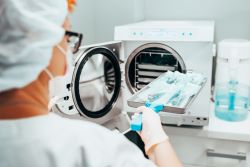Infection Prevention and Control Strategies for Managing Reusable Medical Instruments and Devices in Senior Care Organizations
Senior care organizations, like other healthcare facilities, must make deliberate and coordinated efforts to prevent and control infectious diseases and outbreaks. The vulnerability of the population that these organizations serve makes the need to implement infection prevention and control (IPC) strategies even more pronounced. Senior care residents often are at heightened risk for infections as a result of declining health, comorbidities, frequent interactions with caregivers, open wounds, use of medical devices, and other factors.1
| Important Note |
|---|
| The types of medical instruments and devices used in senior care organizations vary. Not all guidance in this article applies to all facilities. Each organization should determine appropriate IPC efforts based on the facility and resident population. |
Various methods can help senior care facilities prevent and control the spread infections among residents. One area to target as part of IPC initiatives is the appropriate and thorough decontamination of reusable medical instruments and devices, such as podiatry equipment, thermometers, otoscopes, stethoscopes, ultrasound equipment, blood pressure cuffs, electric razors, etc.
Senior care leaders and staff members should consider the following risk management strategies related to medical instruments and devices as part of their overall IPC plan.
Strategies for Reprocessing Reusable Medical Instruments and Devices
- Make sure that reusable instruments and devices are clearly differentiated from single-use disposable devices.
- Reinforce that staff members should not reuse single-use disposable instruments and devices under any circumstances or in any situation.
- For each reusable instrument or device, determine the level of disinfection or sterilization needed. The level will depend on how the item is used.2
- Critical instruments/devices are those that (a) enter sterile tissue or the vascular system, or (b) transport bodily fluids (e.g., blood). These instruments/devices require thorough cleaning and sterilization.
- Semi-critical instruments/devices are those that contact mucous membranes or skin that is not intact. These instruments/devices require thorough cleaning and high-level disinfection.
- Noncritical instruments/devices are those that contact only intact skin or have no contact with the resident. These instruments/devices require low-level disinfection.
- Develop written policies and procedures for reprocessing reusable instruments and devices. Keep policies, procedures, and manufacturer’s reprocessing instructions for reusable medical instruments and devices in reprocessing areas.
- Provide training and validate competency for employees processing reusable medical instruments and devices. Training should occur at least annually as well as when new equipment is introduced.
- Provide thorough guidance for the appropriate use of personal protective equipment during reprocessing procedures.
Strategies for Sterilizing Reusable Medical Instruments and Devices
- Ensure that the organization’s IPC policies require appropriate cleaning, decontamination, and sterilization of critical reusable instruments and devices.
- Establish standards for routine maintenance of sterilization equipment according to manufacturer instructions.
- Implement biological monitoring of the sterilization process.
- Develop written policies and procedures for managing reprocessing errors or failures.
Strategies for High-Level Disinfection of Reusable Medical Instruments and Devices
- Ensure that the organization’s IPC policies require at least thorough cleaning and high-level disinfection for reusable semi-critical medical instruments and devices.
- Validate that high-level disinfection procedures require use of Food and Drug Administration-cleared high-level disinfectants and manufacturers’ recommended exposure conditions. Ensure adequate supplies of the product(s).
- Develop a system for identifying which instrument was used on which resident.
- Perform routine maintenance on high-level disinfection equipment according to manufacturer guidelines.
Strategies for Low-Level Disinfection of Reusable Medical Instruments and Devices
- Implement a policy for low-level disinfection of noncritical medical instruments and devices. Disinfection should occur periodically or when the items are visibly soiled.3
- Ensure that adequate supplies of a disinfectant or germicide approved for use in healthcare facilities is available and accessible to staff.
For more detailed information about reprocessing reusable medical instruments and devices, see the various resources from the Centers for Disease Control and Prevention’s Healthcare Infection Control Practices Advisory Committee as well as the Association for Professionals in Infection Control and Epidemiology’s disinfection and sterilization resources.
Endnotes
1 Centers for Disease Control and Prevention. (n.d.). Core elements for antibiotic stewardship in nursing homes: Top 10 infection prevention questions to ask a nursing home’s leaders. Retrieved from www.cdc.gov/antibiotic-use/core-elements/pdfs/factsheet-core-elements-10-infection-prevention-questions-508.pdf
2 Centers for Medicare & Medicaid Services. (2009, December 2). CMS manual system: Revisions to appendix PP – “Interpretive Guidelines for Long-Term Care Facilities,” Tag F441 (Transmittal 55). Department of Health and Human Services. Retrieved from www.cms.gov/Regulations-and-Guidance/Guidance/Transmittals/downloads/ r55soma.pdf; Rutala, W. A., Weber, D. J., & The Healthcare Infection Control Practices Advisory Committee (HICPAC). (2019, updated). Guideline for disinfection and sterilization in healthcare facilities, 2008. Centers for Disease Control and Prevention. Retrieved from www.cdc.gov/infectioncontrol/guidelines/disinfection/index.html
3 Centers for Medicare & Medicaid Services, Revisions to appendix PP – “Interpretive Guidelines for Long-Term Care Facilities,” Tag F441 (Transmittal 55).



